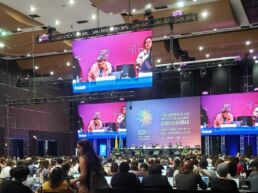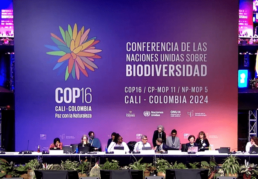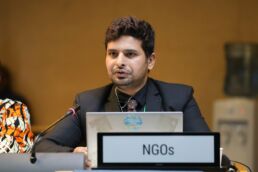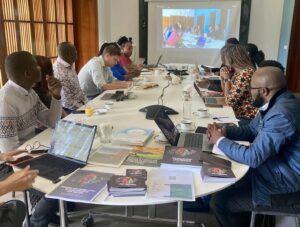News
The CBD as a vehicle to promote biotechnology?
Fresh from COP16, our campaigner reports on the push to shift the CBD’s focus from regulating gene drives and other biotechnologies to promoting them—putting biodiversity at risk. Read the full article as published in today’s ECO:
As biotechnology reaches ever greater capabilities to “re-design” nature, some want to turn the CBD into a place for the promotion rather than regulation of biotechnology. Parties to the Convention cannot let this happen, warns German-based NGO Save Our Seeds.
When the CBD was first written, biotechnology was – rightly – seen as a threat to biodiversity and its sustainable use. The Convention’s text focusses on the risks arising from the use and release of genetically engi-neered organisms, although it also talks about sharing the “results and benefits arising from biotechnologies” when they are based on genetic resources from deve-loping countries.
Fast forward to 2024 and the situation is very different. In the CBD context, there is more and more language about the potential benefits of biotechnology, to the detriment of the precautionary approach enshrined in the Convention.
This comes at a time when biotechnology is becoming ever more powerful. Organisms are no longer just “genetically modified” but increasingly “new-to-nature”. The CBD uses the term “synthetic biology” for the “further development and new dimension of modern biotechnology” based on tools such as DNA synthesis, next-generation sequencing, bioinformatics, and genome editing.
Synthetic biology tools have long been used to engineer microbes producing pharmaceuticals or food ingredients in contained facilities. However, more recent applications are also for use in open environments, such as microbes engineered to support the uptake of fertilizer in crops.
A multidisciplinary expert group (mAHTEG) of the CBD has looked into aspects such as the “integration of artificial intelligence and machine learning”, “self-spreading vaccines for wildlife” and “engineered gene drives to control vector-borne diseases and invasive species” (Document CBD/SYNBIO/AHTEG/2024/1/3). The expert group was meant to look into the future and inform CBD Parties about things to come. But the future is already here. Artificial intelligence is being rapidly taken up for engineering microbes and proteins, and “self-limiting” insects have already been released in places like Brazil and the US. The experimental release of gene drive mosquitoes, originally planned for 2024, is still being pursued in Uganda and other African countries.
Such extreme forms of genetic engineering represent a whole new dimension of environmental risk. Gene drives, for one, are intended to alter or exterminate whole populations of wild species, resulting in potentially irreversible harm even beyond the country of release. The precautionary principle, enshrined in the CBD more than 30 years ago, has never been more precious and indispensable for the protection of nature and people.
But a handful of Parties such as Brazil and the UK, are intent on blocking any in-depth assessment of the issues considered by the expert group. Instead, they say the CBD should look into potential positive impacts and benefits that synthetic biology can deliver for the achievement of the KMGBF.
Biotechnology interests are also at work in other CBD workstreams. A draft paper on plant conservation (CRP 1) proposes to “support research and development … to enhance the benefits arising from the use of safe biotechnologies”. Another draft on biodiversity and health (CRP 6) wants to “promote the sharing of benefits for health arising from biotechnological developments”.
Luckily, not all Parties are blind to the potential problems arising from genetic engineering and a proposed non-paper on synthetic biology remains highly controversial. Let’s hope that reason prevails, and the CBD will not only continue to caution against negative outcomes but manage to effectively regulate these powerful technologies.
COP16 – what is at stake for gene drives?
Parties to the “Rio” Convention on Biological Diversity (CBD) and the Cartagena Protocol are meeting in Cali, Colombia, between October 21 to November 1, 2024. What is at stake for gene drives in the coming days?
Gene drives are on the agenda under two key items, under “Synthetic Biology” within the CBD’s Conference of the Parties (COP), and under "Risk Assessment and Risk Management" within the Cartagena Protocol’s Meeting of the Parties (MOP).
Two crucial reports are up for discussion—one from a multidisciplinary Ad Hoc Technical Expert Group (mAHTEG) on Synthetic Biology including horizon scanning, technology assessment, and monitoring, and another one from a (not so multidisciplinary) Ad Hoc Technical Expert Group (AHTEG) outlining risk assessment guidelines for gene drive organisms.
Report on Synthetic Biology
At COP15 in 2022, a multidisciplinary group was tasked with conducting horizon scanning on emerging technologies that could impact biodiversity. The group presented initial findings on five issues including gene drives, and Parties proposed during a preparatory meeting to COP16 that the mAHTEG should conduct an in-depth assessment of several issues including “potential impacts of engineered gene drives to control vector-borne diseases and invasive species”.
However, gene drive developers are pushing back against any specific consideration of gene drives and several countries, such as Brazil, Argentina, Canada and New Zealand (see previous ECO article about this group) are lobbying to stop any further work by the mAHTEG. Instead, they are proposing an "action plan on synthetic biology," which could pave the way for the global development and transfer of gene drive technologies. The Stop Gene Drives campaign is actively pushing to ensure that gene drives undergo a thorough assessment.
Gene Drive Risk Assessment Guidance
Parties to the Cartagena Protocol are likely to “welcome” the guidance materials for the risk assessment of living modified organisms containing engineered gene drives developed by an Ad Hoc Technical Expert Group earlier this year. This is despite the fact that the Guidance is not sufficiently precautionary, according to scientists from the European Network of Scientists for Social and Environmental Responsibility (ENSSER). It shifts the burden of proof from having to prove safety to having to prove harm and uses a “problem formulation approach” that is not fit for purpose. This approach was introduced by Mr. John Connolly, the Senior Regulatory Science Officer for Target Malaria, an organisation aiming to release gene drive mosquitoes in Africa.
Initially, many Parties including the EU, UK and others wanted to go further and ”endorse“ the guidance. But in a late-night session on the third day of the COP-MOP, Parties went with the less strong wording “welcome”. However, the Guidance will not be subject to a wider independent review, as our NGO coalition had asked for. It remains to be seen whether and how it will be used in the context of planned releases of gene drives.
Read our detailed brief for more insights here.
COP16: Precaution and integrity at stake in the guidance materials on risk assessment of LMOs containing engineered gene drives
As participants in the 16th Cnference of the Parties (COP 16) of the UN Convention on Biological Diversity (CBD), we will be sharing insights through articles authored by members of the CBD-Alliance’s Working Group on Synthetic Biology, to which we belong.
Key topics of discussion at the Cali conference include synthetic biology and the risk assessment of gene drives. For more detailed information on the issues at play, we invite you to consult the briefing we have developed in preparation for this conference.
Several NGOs are hosting a side event today to raise awareness among delegates about the potential impacts of the current risk assessment guidelines for gene drives on our ecosystems and the integrity of the Cartagena Protocol. More information on the speakers, including three who have served as members of the AHTEG involved in developing the guidelines and can provide insights into the AHTEG’s dynamics, as well as their talking points, can be found here.
Our partner Dr Eva Sirinathsinghji from Third World Network details in her article below several of the shortcoming of these guidelines.
Precaution and integrity at stake in the guidance materials on risk assessment of LMOs containing engineered gene drives
Living modified organisms containing engineered gene drives (EGD-LMOs) are a new form of genetic engineering (GE) application that raises a host of concerns spanning biosafety, socio-economic, ethical, and cultural dimensions due to their explicit design intention of spread and persistence. Compounding these concerns is the inability to recall or reverse a gene drive release if the technology goes awry.
Due to the fundamental challenges they raise to the ability to conduct robust and reliable risk assessments, an AHTEG was set up to draft additional voluntary guidance materials. Such guidance materials should set out a precautionary approach, as outlined in previous decisions (14/19, CP-9/13, and XIII/17). Unfortunately, the new guidance materials that will be considered in Cali do not advance a precautionary approach. Instead, the use of a new approach (‘pathways to harm’ under a ‘problem formulation approach’) for conducting risk assessments has been introduced. It narrows the risk assessment framing and scope, minimizes data requirements for assessing risks, and fails to address the central and most controversial risks and uncertainties of EGD-LMOs – their uncontrolled spread and persistence. This raises challenges for alignment with specific aspects of the Cartagena Protocol on Biosafety. Instead, the approach aligns with industry methods of streamlining risk assessments that have been long promoted for GE crops, and thus is not well equipped to deal with the risks and uncertainties associated with EGD-LMOs.
Most concerningly, the prominent role played by a member of the AHTEG who is affiliated with an entity that is considered one of, if not the, leading gene drive projects globally, raises doubts regarding the integrity of the guidance materials. This member played a prominent role in advocating for the adopted methods as well as taking lead roles in the early drafting of sections of the document that relate to the project of the developer. This regrettably casts doubts over the integrity of the guidance materials. This case has been highlighted at SBI-4 (paras 13-15 of CBD/SBI/4/11/Add.1). It has also, in part, led to proposed amendments to improve the procedure for avoiding or managing conflicts of interest in expert groups, which will be considered at COP16.
The guidance materials are not yet ready to be welcomed by Parties. They should instead be subject to independent review before they can be put to use. Precaution and integrity cannot be compromised at the hands of industry.
IUCN regional meeting avoids discussion on genetic engineering in natural ecosystems
As scientists and environmentalists grapple with synthetic biology, a crucial debate failed to materialize at the IUCN regional meeting in Bruges, Belgium. Instead, the meeting revealed significant concerns about the organization's policy development process on synthetic biology and its implications for nature conservation.
A Process Under Scrutiny
Despite IUCN Chief Scientist Tom Brooks characterizing it as "the most participatory process the IUCN ever had," many members are raising red flags. During a recent side event – that explicitly aimed to merely talk about the process; not the content of the policy - Dr. Ricarda Steinbrecher voiced a concern that echoes throughout the conservation community: "This topic is so complex, and something is lacking in the process. How can members vote on a policy in 2025 when many still haven't grasped what synthetic biology truly entails?"
The Path to Policy: A Rocky Road
The journey began in 2021 in Marseille with Resolution 123, which called for a balanced working group representing diverse perspectives, genders, regions, and knowledge systems. However, the implementation has sparked controversy. Instead of relying solely on this comprehensive group, the Secretariat:
- Created a separate 'citizens council' of just 15 IUCN members
- Partnered with the International Centre for Genetic Engineering and Biotechnology (ICGEB) for training workshops—a decision that raised eyebrows due to potential conflict of interest
- Drew criticism from over 80 NGOs who called for a halt to the process, citing concerns about participation and transparency
The Current Draft: More Questions Than Answers
The draft policy, to be presented at the World Conservation Congress in Abu Dhabi in October 2025, has significant shortcomings in its current form:
- Uses overly broad definitions of synthetic biology
- Avoids specific references to concrete technologies like Gene Drives
- Lacks clear guidelines on risk assessment and cut-off criteria
- Relies heavily on case-by-case assessments without establishing firm frameworks
The Stakes Are High
As one IUCN member pointedly noted, transparency requires explicit discussion of genetic engineering in the wild. The current approach risks creating a "zero impact document" that could be interpreted in vastly different ways by governments, industry, and other stakeholders.
Time for Action
The window for meaningful debate is closing rapidly. A growing coalition of NGOs is already mobilising to push for strong regulations that prioritise ecological and ethical standards. The press release and briefing for this regional meeting can be found here, including ways to get engaged.
Recap of SBSTTA 26 - what happened to gene drives?
At the 26th meeting of the Subsidiary Body on Scientific, Technical and Technological Advice (SBSTTA 26) to the Convention of Biological Diversity (CBD) Gene Drives received significant attention in the context of the CBD’s horizon scanning of new challenges arising from synthetic biology as well as the Biosafety Protocol’s guidelines for risk assessment and risk management. Stop Gene Drives followed closely the preparation of texts to be adopted at the upcoming Conference of the Parties (COP16) in Cali, Colombia, this October.
At the last COP15 in 2022, adopting the "Kunming-Montreal Global Biodiversity Framework 2020", two pivotal decisions concerning Synthetic Biology and the risk assessment of Gene Drives had been adopted and two ad hoc technical expert groups (AHTEG) were established. A multidisciplinary one (mAHTEG) was charged with designing a horizon scanning, technology assessment, and monitoring methodology to evaluate impacts of future technologies on biodiversity. It’s 'multidisciplinary' was hard-won and is still a contentious issue. Barbara Pilz of Stop Gene Drives was amongst the members of this group. The second AHTEG with no m focused on developing voluntary guidelines for the risk assessment of mosquitoes containing genetically engineered Gene Drives.
The groups produced reports on synthetic biology and on case-by-case risk assessment of living modified organisms containing engineered gene drives. From these reports national representatives gathered in Nairobi were expected to draft recommendations for COP16.
The first day of SBSTTA 26 saw both topics discussed in the plenary, allowing the Chair to gauge whether these issues were contentious enough to warrant further group discussions (called “contact groups” in UNish) or if they could be addressed in the plenary itself. The risk assessment guidelines for engineered Gene Drives, developed by the AHTEG, identified major risks and uncertainties, such as gene flow to non-target species, potential transboundary movements, and significant public health risks. While these guidelines provided a foundation, they were criticized for using methodologies for GMO assessment and not a Gene Drive specific assessment. Questions about potential conflicts of interest within this AHTEG were raised.
The discussions on the AHTEG were less controversial compared to those on synthetic biology. However, significant portions of the text were put in brackets, indicating that no consensus was reached at the SBBSTA and further discussions will be needed at COP16. The majority in the plenary welcomed the work of AHTEG. However, while some argued that there was no need for further AHTEG meetings, many countries, particularly African nations where Gene Drives might first be tested, called for more refined guidelines that could truly aid practitioners in assessing gene drive risks. COP16 will now have to decide whether the Cartagena Protocol maintains its expert group and continues providing oversight and resources to the parties, or closes this chapter. As usual, there was a general agreement on the need for increased capacity building. NGO as well as Youth observer groups emphasized the precautionary principle, criticized the overreliance on computer modeling in the guidance materials. They called for further AHTEG sessions and refined methodologies.
In the synthetic biology discussions, the report from the multidisciplinary ad hoc technical expert group (mAHTEG) was insightful, despite the limited time available to assess technologies after extensive methodology development. The experts recognized that some assessed technologies warranted precautionary measures and broader evaluations including socio-economic, cultural, and ethical considerations. The report specifically recommended to conduct such in-depth assessments for Gene Drives. During the debates, there was a clear division between those favoring continued horizon scanning and others advocating for a shift towards capacity building. The African group generally saw the value in an expert group that could assess emerging technologies and inform state decisions, also calling for capacity building, technology transfer, and cooperation in the field of synthetic biology. However, differences emerged on what this would entail, with asking when discussions would shift from risks to benefits, hinting at an interest in developing Gene Drives. Meanwhile, other African states sought "appropriate" technology transfers to avoid becoming dumping grounds for untested and unsafe Western technologies.
A faction within the room, particularly Argentina, Brazil, Japan, and New Zealand, strongly supported the call for recognizing benefits. During the plenary, Argentina proposed an action plan on synthetic biology that would promote such technologies globally.
The two options at hand during the contact group were quite opposing:
- continuation of the mAHTEG with proper horizon scanning and capacity building also for risk assessment and monitoring
- promotion of synthetic biology worldwide with a new action plan, and reducing the mAHTEG to conduct a literature review
Brazil criticized the mAHTEG members as lacking expertise and other states supported this reasoning. The mAHTEG’s assessments that these technologies posed risks not only to biodiversity but also to society and livelihoods were obviously not well received by states promoting synthetic biology. There were further attempts to obstruct the process, in line with an incident at COP15 where a delegate boasted about "killing the process" before COP16.
The recommendations SBSTTA delegates finally agreed to send to COP16 fails to reflect the mAHTEG's clear formulations and recommendations, particularly on Gene Drives. It is crucial that the mAHTEG continues in its current or an enhanced form, and not be diminished to only review predominantly English literature from mostly Western institutions and patent holders. Also, capacity building and technology transfer must reduce disparities between more or less industrialised countries, rather than serving as avenues for testing potentially harmful technologies.
The document prepared for COP16 suggests that the current methodologies are sufficient for assessing environmental and socio-economic impacts of Gene Drives, which is misleading. These methodologies were originally designed to assess the risks of GMOs cultivated and traded in restricted agricultural environments. These are fundamentally different from Gene Drives, designed to spread in the environment and alter entire species in their wild habitats. This inadequacy extends to monitoring capabilities, making it challenging to manage GDOs effectively if issues arise.
Significant efforts are required both before and during COP16 to ensure that parties advocate for the continuation of the mAHTEG on horizon scanning for synthetic biology and the AHTEG on risk assessment. These efforts are crucial for developing a truly robust methodology for assessing the risks associated with Gene Drives.
Seminar and Press Conference on Gene Drives in Nairobi
This morning, Friday 17th of May, Save Our Seeds with Pollinis hosted a hybrid seminar on GMOs and gene drives. This event offered an exceptional opportunity to gain insights into the political landscape surrounding GMOs and the increasingly contentious topic of gene drives currently under consideration at the United Nations Convention on Biological Diversity. Our expert speakers, fresh from the recent SBSTTA discussions, shed light on what transpired during those crucial debates and what it means for local contexts.
Following the seminar we hosted a press conference attended by journalists from several African countries.
Press Release
UN Body Considers Risky New Genetic Technologies: Civil Society Urges Precaution
Nairobi, Kenya, May 17 2024: Parties to the United Nations Convention on Biological Diversity (CBD) are currently discussing controversial technologies in Nairobi. One such technology is engineered gene drives. It is a form of extreme genetic engineering which is designed to spread its modification throughout an entire species and persist in the environment. In Africa, gene drive projects, largely funded by the Bill and Melinda Gates Foundation, are already underway in several countries including Burkina Faso, Ghana, Uganda and most recently in Tanzania, aiming to eradicate malaria. However, these techno-fixes do not address the root causes of health challenges on the continent and pose novel risks. Furthermore, these projects are proceeding despite the absence of adequate local capacity to assess and regulate them effectively.
While gene drive lobbyists, at the 26th meeting of the Subsidiary Body on Scientific, Technical and Technological Advice (SBSTTA) to the CBD in Nairobi, use the possibility of malaria eradication to promote the technology, civil society organizations have found that most patents are being filed for agricultural use. Patents reference hundreds of agricultural uses, such as for herbicides, pesticides and so called “pests”. Researchers found that agribusiness firms such as Monsanto-Bayer and Cibus Bioscience were also engaging with gene drive development.
At this year’s SBSTTA meeting, member states are examining reports from expert groups, highlighting numerous risks and unanswered questions about gene drives. Discussions are particularly focused on the contrasting potential benefits and risks these technologies might pose. Sub-Saharan countries are advocating for enhanced capacity building, technology transfer, and some seem to be willing to adopt gene drives. African civil society organizations (CSOs) are calling for ongoing evaluations and a robust, updated regulatory framework to manage these technologies. They endorse a precautionary approach and support the establishment of an international expert group to review new technologies before they are introduced to the environment.
Decisions made at SBSTTA will be taken to the Conference of the Parties to the CBD in October 2024 to be further discussed, where heads of states will decide on how to proceed with these technologies.
Contacts:
Sabrina Masinjila
African Centre for Biodiversity
+255 767 089 834
Barbara Ntambirweki
ETC Group Uganda
bntamby@gmail.com
References:
Gene Drive Brochure
Forcing the Farm:
https://www.etcgroup.org/content/forcing-farm
SBSTTA 26: Urgent need for international biosafety oversight and the right to say no, as gene drive mosquito projects expand in Africa
As participants in the 26th Subsidiary Body on Scientific, Technical, and Technological Advice (SBSTTA 26) of the UN Convention on Biological Diversity (CBD), we will be sharing insights through articles authored by members of the CBD-Alliance’s Working Group on Synthetic Biology, to which we belong.
Key topics of discussion at the Nairobi conference include synthetic biology and the risk assessment of gene drives. For more detailed information on the issues at play, we invite you to consult the briefings (short/long) we have developed in preparation for this conference.
Please find below an article by our partner Sabrina Masinjila from the African Centre for Biodiversity:
Urgent need for international biosafety oversight and the right to say no, as gene drive
mosquito projects expand in Africa
Gene drives, a form of synthetic biology, pose significant risks with their potential to alter entire species, including driving them to extinction. Discussions on gene drives under the Convention of Biological Diversity (CBD) have been extremely contentious, as those with vested interests have been blocking international biosafety regulation and oversight.
Projects like Target Malaria and Transmission Zero (T0) are advancing the deployment of gene-drive mosquitoes, primarily targeting malaria-carrying Anopheles mosquitoes, in both West and East African countries. However, these initiatives have proceeded in the absence of internationally agreed biosafety standards to govern risk assessment and management during the contained use experimental phase as well as open releases.
This is compounded by scant biosafety institutional and regulatory capacity in Africa, a lack of regulatory experience, and no transparency in terms of information, as required by the Cartagena Protocol on Biosafety and national biosafety regulations.
African civil society in Tanzania, for example, where the T0 project operates, have raised concerns about limited wider public consultation and access to pertinent documents.
While malaria is a huge public health challenge in Africa, investments should focus on systemic solutions that provide adequate healthcare, clean water, and sanitation.
Please see ACB’s new blog for more detail: https://acbio.org.za/gm-biosafety/expansion-of-gene-drive-mosquito-projects-in-africa/
Gene drive organisms pose unacceptable risks to biodiversity and human health and the draft guidance for risk assessment developed under the CBD to date is not comprehensive enough to address the uncertainties. Further guidance that invokes the precautionary principle and the right to say no is essential. We strongly urge African governments to support further guidance under the CBD that provides thorough methodologies capable of fully addressing the risks.
SBSTTA 26: Robust risk assessment needed for LMOs containing engineered gene drives
As participants in the 26th Subsidiary Body on Scientific, Technical, and Technological Advice (SBSTTA 26) of the UN Convention on Biological Diversity (CBD), we will be sharing insights through articles authored by members of the CBD-Alliance's Working Group on Synthetic Biology, to which we belong.
Key topics of discussion at the Nairobi conference include synthetic biology and the risk assessment of gene drives. For more detailed information on the issues at play, we invite you to consult the briefings (short/long) we have developed in preparation for this conference.
Please find below an article by our partner Dr Eva Sirinathsinghji from Third World Network:
Robust risk assessment needed for LMOs containing engineered gene drives
The development of living-modified organisms containing engineered gene drives (EGD-LMOs) has raised significant controversy due to their explicit design intention of spread and persistence within wild populations.
The novelties of EGD-LMOs raise fundamental challenges to (i) the ability to assess risk; (ii) the capacity to mitigate or recall them; (iii) the ability to prevent transboundary movement; (iv) assessment of socio-economic impacts; (v) operationalizing mechanisms of obtaining free, prior and informed consent; and (vi) liability and redress.
In decision 14/19, Parties recognized that specific guidance may be useful for the risk assessment of EGD-LMOs and set out precautionary conditions that should be met before any consideration of environmental release. The AHTEG on Risk Assessment has now developed guidance materials, for discussion at SBSTTA-26.
The guidance identifies major risks and uncertainties of EGD-LMOs, including the potential for gene flow to non-target species, the likely inability to isolate or prevent transboundary movement for some EGD-LMOs, and potential serious risks to human health for public health applications.
However, while the guidance provides a starting point, it lacks methodological guidance on how to address the identified risks and uncertainties. There is an overemphasis on describing a new methodology, but not how it can be applied specifically to EGD-LMOs.
Moreover, concerns were raised over a potential conflict of interest involving a member of the AHTEG, and an associated failure by this individual to disclose the relevant situation in accordance with decision 14/33.
We therefore call on Parties to:
- Improve the draft guidance materials and define appropriate modalities to do so
- Ensure the proper application of the procedure for avoiding or managing conflicts of interest, including adopting the amendments set out in CBD/SBI/4/11
- Ensure a wider assessment of the socioeconomic, cultural, and ethical impacts of EGD-LMOs
- Reaffirm the precautionary approach and ensure no release of high-risk and unassessed EGD-LMOs.
SBSTTA 26: Ensuring good governance of synthetic biology
As participants in the 26th Subsidiary Body on Scientific, Technical, and Technological Advice (SBSTTA 26) of the UN Convention on Biological Diversity (CBD), we will be sharing insights through articles authored by members of the CBD-Alliance's Working Group on Synthetic Biology, to which we belong.
Key topics of discussion at the Nairobi conference include synthetic biology and the risk assessment of gene drives. For more detailed information on the issues at play, we invite you to consult the briefings (short/long) we have developed in preparation for this conference.
Please find below an introductory article from the Working Group on Synthetic Biology:
Ensuring good governance of synthetic biology
At the Conference of Parties (COP) 15 of the Convention of Biodiversity, Parties established, in Decision 15/31, a “broad and regular” process of multidisciplinary horizon scanning, assessment and monitoring of new developments in Synthetic Biology. The need for this process was already identified by Parties in Decision 14/19, and provides a means for governments to collaboratively track and provide timely responses to biodiversity threats and opportunities emerging from modern biotechnology developments.
In the past two years, the multidisciplinary Ad Hoc Technical Expert Group (mATHEG) on Synthetic Biology undertook extensive work to design, review and test a working methodology for the broad and regular process. This was reported as Annex IV of CBD/ SBSTTA/26/4. It involves an expert-driven process with multiple steps of information gathering, synthesis, screening, selection, filtration, and analysis.
The mAHTEG identified 5 priority topics for assessment: self-spreading vaccines for wildlife, self- limiting insect systems, development of engineered gene drives to control vector-borne diseases and invasive species, integration of artificial Intelligence and machine learning, and inequity in the participation of developing countries in the context of synthetic biology.
The group undertook a first round of multidisciplinary horizon scanning, monitoring, and assessment for these 5 topics, reported their findings, and articulated proposals for further policy work.
They identified key areas of developments for policy attention, and issued a set of recommendations to the SBSTTA. Read the CBDA Working group on synthetic biology brief on this topic here- https://cbd-alliance.org/en/2024/factsheet-synthetic-biology
Drawing on the work of the mAHTEG, we believe the Parties at SBSTTA 26 should:
- Agree the methodology of the broad and regular process, as outlined and road-tested by the mAHTEG, and confirm that the process should occur at least each biennium (ie; between every COP).
- Re-emphasize the importance of multidisciplinarity and precaution to the functioning of the broad and regular process.
- Initiate timely policy formulation processes on priority topics identified by the mAHTEG, including 1. The Integration of Artificial Intelligence (AI) with synthetic biology and 2. Self- spreading vaccines for wildlife.
- Request that assessment guidelines on gene drives also incorporate socioeconomic, cultural, and ethical impacts.
- Address other topics raised by the mAHTEG: including issues of North-South equity, self- limiting insects, technology facilitation, and capacity-building for horizon scanning, assessment and monitoring activities.
- Ensure no release of high risk and unassessed synthetic biology organisms, components, or products takes place.
World Malaria Day 2023 and the gene drives deception
World Malaria Day 2023 and the gene drives deception
At the occasion of World Malaria Day (25 April), the Stop Gene Drives Campaign encourages you to take a closer look at the insights and perspectives shared by prominent actors and other organisations closely monitoring the subject on this significant day.
By 2030, the World Health Organization (WHO) hopes to reduce the global malaria burden by ninety percent (in comparison to a 2015 baseline). Running against the clock, facing unforeseen obstacles, and with multiple interests on the table, recent years have seen setbacks in the progress of malaria control.
Particularly during the Covid-19 pandemic, health service disruptions, diverted resources, and reduced access to affected communities posed concrete obstacles towards the 2030 target.
Aiming at overcoming such obstacles and accelerating the process, the 2023 World Malaria Day was marked by the theme “Time to deliver zero malaria: invest, innovate, implement”. On social media and online, this slogan was well exploited to reinforce a narrative in which biotechnology (particularly gene drives) is the pinnacle of innovation in malaria control.
We invite you to look at a few examples and join us in uncovering the stories behind them.
A new type of celebrity
Target Malaria, a controversial research consortium backed by US military funding from DARPA, took the opportunity to reinforce its narrative of innovation equals solution.
In their story, scientists are the equivalent of rockstars, who will use their latest creations to save the world from malaria. They insist that urgent innovation (i.e. new genetic technologies, particularly gene drives to eradicate mosquitos) is the only viable remedy in the face of the critical situation. This scenario, in their view, seems to exist is a vacuum where risks are minimal and negative consequences are not taken into account. Other organisations followed a similar recipe of presenting ‘science and innovation’ as the (only) tools that can put malaria control back on track. (See examples here, here and here)
This tunnel-vision narrative is dangerous and deceptive. In addition to spreading misinformation, efforts that are led by pressure to produce immediate results and return on investment, can easily overlook risks, produce flawed results, and only address issues at surface level. In addition to that, it creates momentum towards a false idea that a final solution to the malaria burden has been found – which is unfortunately still not a reality.
A deep wound cannot be treated with a bandage
Fighting malaria is a complex issue that requires structural and long-term solutions. The push for the deployment of technologies (such as gene drives) ignores both ecological risks and context-related challenges.
At the occasion of World Malaria Day 2023, several organisations and actors raised concerns about why it is crucial to go beyond the superficial, quick-fix/technical aspect of fighting malaria.
The most recurrent concerns highlighted the need to also fight socio-economic and infrastructural factors that enable the prevalence of malaria. These include poverty, gender and other inequalities, inadequate water, sanitation, and hygiene infrastructure, and lack of access to education and healthcare.
Some argue that every malaria case is preventable and avoidable, urging global leaders to increase funding and action. They promote different tools such as enhanced bed nets, vaccines, monoclonal antibodies, and mosquito sugar baits. Advocating for a holistic approach that provides communities with necessary tools and addresses underlying causes. (See examples here, here, and here)
What else is there to uncover?
There seems to be a consensus among those engaged in eradicating malaria that progress towards a dramatic reduction by 2030 is delayed. In this context, narratives that advocate for rushed ‘innovation’ and new technologies as the solution tend to overlook risks and potential irreversible ripple effects.
The emergency of new challenges, such as the detection of a new malaria vector in Sub-Saharan Africa, highlights the importance of carefully considering whether technofixes can soon become obsolete. This is in addition to being sensitive to the myriad of cascading effects that the deployment of an unpredictable and irreversible technology could have in ecosystems and human health.
Research aimed at malaria eradication should be conducted with caution and responsibility as well as be based on serious and accurate scientific methods and findings. Furthermore, it should explore multiple solutions and alternatives (e.g., nets, antimalarial drugs, vaccine, etc.) and not exist in isolation from its context. All efforts to reduce the malaria burden need to consider and address the underlying socio-economic and infrastructural factors that contribute to its prevalence.
Finally, breaking down the narratives and stories being communicated on the topic can be helpful to uncover hidden agendas and identify oversights in the evaluation of tools and methods to eradicate malaria. Hopefully, contributing to a more adequate and informed evaluation of options and balanced and responsible decision-making in fighting malaria.
Further resources:
Learn more here about the applications and risks of gene drives in the context of malaria eradication.
Access here the African Center for Biodiversity’s analysis on the linkages between capitalism and malaria.
Watch here an interview with Burkinabé activists Ali Tapsoba and Guy Yameogo assessing community engagement for gene drive release in their country.
Access here some insights from front line workers on the issue of gene drives and malaria.











